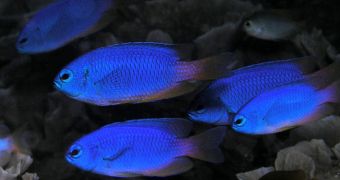According to a new scientific investigation, it would appear that unseasonal temperature variations brought on by the El Nino atmospheric pattern is have a tremendous effect on fish populations living in South Pacific coral reefs.
The conclusion belongs to an international team of biologists, that spent more then four years on the atoll of Rangiroa in French Polynesia, investigating young fish arrival patterns.
These patterns are very important, given that certain fish species can spawn their youngsters up to thousand of kilometers away from their home reef, for protection.
After developing sufficiently, the new generations of fish return to the reef, guided by the natural noises it makes, as well as a host of other environmental factors, scientists now know.
During the investigations, the researchers collected data on these migration patterns, and then cross-referenced their results with datasets obtained from satellite and oceanographic studies.
A sudden population collapse was discovered to have taken place in the plankton community, and the team determined that effects of the El Nino event are to be blamed for this.
As plankton disappeared, or became only scarcely available, younger fish stocks also dwindled, as they had nothing to eat. Adult fish populations were therefore not replenished, and experiences a substantial drop in numbers.
Unwittingly, coral reef fish may be signing their own death sentence. While spreading their youngsters in waters around the reef was a good survival strategy before, global warming and pollution are starting to transform it into these creatures' Achilles' heel.
The researcher were able to measure the number of young fish returning to their home reef on Rangiroa atoll using crest nets, which trapped the youngsters. The four years of study included the 1997-1998 El Nino event.
In a paper appearing in the latest issue of the esteemed journal Global Change Biology, researchers say that a significant drop was recorded in the number of young fish returning to replenish adult stocks.
“Near to the equator, fish arrive throughout the year to replenish adult populations. In contrast, during the El Niño event at Rangiroa, when temperatures climbed up to 3.5°C above the seasonal average, we found that the young fish virtually disappeared,” says Dr Steve Simpson.
“Analysis of satellite images around Rangiroa suggested that plankton, the food supply for many baby and adult reef fishes, declined dramatically during the warm waters of El Niño,” he goes on to say.
“As a consequence, adults struggled to produce offspring and young fishes were likely to starve when in open waters off reefs,” adds the expert, who is based at the University of Bristol School of Biological Sciences.
“Just 1-2 months after the onset of the warm conditions, the next generation of young fish stopped arriving so that adult stocks were no longer being re-supplied,” he concludes.

 14 DAY TRIAL //
14 DAY TRIAL //